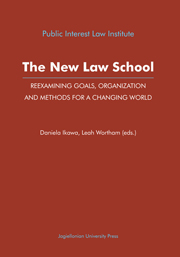11 results
Agenda
- from Appendix
-
- Book:
- The New Law School
- Published by:
- Jagiellonian University Press
- Published online:
- 05 September 2014
- Print publication:
- 31 December 2010, pp 115-117
-
- Chapter
- Export citation
Contents
-
- Book:
- The New Law School
- Published by:
- Jagiellonian University Press
- Published online:
- 05 September 2014
- Print publication:
- 31 December 2010, pp 5-6
-
- Chapter
- Export citation
Frontmatter
-
- Book:
- The New Law School
- Published by:
- Jagiellonian University Press
- Published online:
- 05 September 2014
- Print publication:
- 31 December 2010, pp 1-4
-
- Chapter
- Export citation
Part Four - The Academic Career in Law
-
- Book:
- The New Law School
- Published by:
- Jagiellonian University Press
- Published online:
- 05 September 2014
- Print publication:
- 31 December 2010, pp 79-80
-
- Chapter
- Export citation
Part One - Goals of Legal Education
-
- Book:
- The New Law School
- Published by:
- Jagiellonian University Press
- Published online:
- 05 September 2014
- Print publication:
- 31 December 2010, pp 21-22
-
- Chapter
- Export citation
Introduction
-
-
- Book:
- The New Law School
- Published by:
- Jagiellonian University Press
- Published online:
- 05 September 2014
- Print publication:
- 31 December 2010, pp 11-20
-
- Chapter
- Export citation
Part Two - Law School Governance
-
- Book:
- The New Law School
- Published by:
- Jagiellonian University Press
- Published online:
- 05 September 2014
- Print publication:
- 31 December 2010, pp 33-34
-
- Chapter
- Export citation

The New Law School
- Reexamining Goals, Organization and Methods for a Changing World
-
- Published by:
- Jagiellonian University Press
- Published online:
- 05 September 2014
- Print publication:
- 31 December 2010
Appendix
-
- Book:
- The New Law School
- Published by:
- Jagiellonian University Press
- Published online:
- 05 September 2014
- Print publication:
- 31 December 2010, pp 113-114
-
- Chapter
- Export citation
Part Three - Optimal Academic Curricula and Teaching Methods
-
- Book:
- The New Law School
- Published by:
- Jagiellonian University Press
- Published online:
- 05 September 2014
- Print publication:
- 31 December 2010, pp 45-46
-
- Chapter
- Export citation
Acknowledgments
-
- Book:
- The New Law School
- Published by:
- Jagiellonian University Press
- Published online:
- 05 September 2014
- Print publication:
- 31 December 2010, pp 9-10
-
- Chapter
- Export citation

